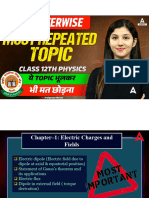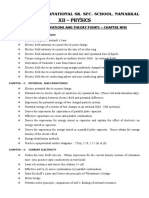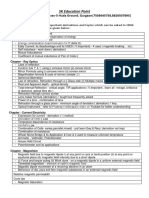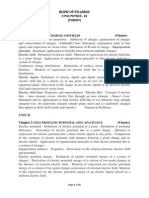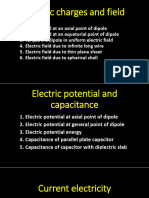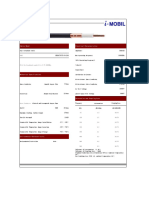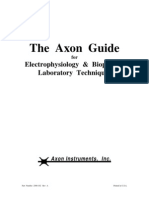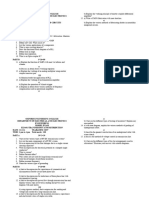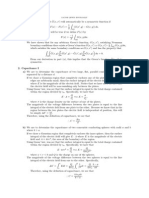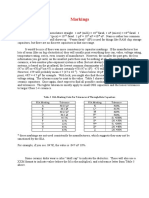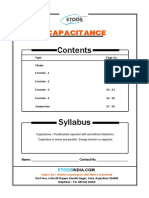List of Derivations Class - Xii (2024-25)
List of Derivations Class - Xii (2024-25)
Uploaded by
snowy5738Copyright:
Available Formats
List of Derivations Class - Xii (2024-25)
List of Derivations Class - Xii (2024-25)
Uploaded by
snowy5738Original Title
Copyright
Available Formats
Share this document
Did you find this document useful?
Is this content inappropriate?
Copyright:
Available Formats
List of Derivations Class - Xii (2024-25)
List of Derivations Class - Xii (2024-25)
Uploaded by
snowy5738Copyright:
Available Formats
LIST OF DERIVATIONS
CLASS : XII ( 2024-25)
SUBJECT : PHYSICS(042)
Chapter –1: Electric Charges and Field
1. Numericals on coulomb’s law.
2. Numericals bades on Electric Field due to a point Charge
3. Electric field Intensity at axial point of an electric dipole .
2. Electric Potential at equatorial point of an electric dipole
3. Torque acting on an electric dipole kept in an electric field .
4. Application of gauss’s Theorem : Infinitely long straight wire , Infinite Plane Sheet and
Uniformly Charged thin spherical shell and numericals based on electric flux.
CHAPTER –2: Potential and Capacitance
1. Numericals based on Electric potential difference due to a point charge
2. Electric potential difference due to dipole : at general point , axial point , equatorial point .
3. Electric potential surfaces its PYQ.
4. Numericals based on potential gradient.
5. Electric potential energy of a dipole in the presence of uniform electric field .
6. Numericals based on capacitance ( graph based numericals)
7. Capacitance of a parallel plate capacitor
8. Capacitance of a parallel plate capacitor having dielectric slab & numericals.
9. Capacitance of a parallel plate capacitor having conducting slab
10. Capacitors in series and parallel & numericals on it along with energy store.
Chapter –3: Current Electricity
1. Drift speed ( define , derivation)
2. I = nAeVd
3. Expression of resistivity in terms of relaxation time and number density
4. Vector form of Ohm’s law
5. Ohmic and non ohmic devices and its graph.
6. Combination of cells with numericals
7. Numericals based on Terminal potential difference.
8. Wheatstone Bridge
9. Kirchhoff’s laws and its numericals
Chapter -4 : Magnetic effects of current
1. Magnetic field at the centre of a circular current loop and along the axis.
2. Ampere Circuital law proof
3. Application of Ampers law to a straight current carrying conductor.
4. Work done by a magnetic force on a charged particle .
5. Force on current carrying conductor in a magnetic field
6. Force between two parallel current carrying conductors
7. Torque experienced by a current loop in a uniform B.
8. Moving coil Galvanometer
9. Conversion of Galvanometer to
Ammeter . 10.Conversion of Galvanometer to
Voltmeter .
Chapter-5 : Magnetism
1. Torque on a magnetic dipole in a uniform magnetic field.
2. Potential energy of a magnetic dipole.
3.Magnetic dipole moment of a revolving electron
4.Relation between magnetic permeability and Susceptibility
5. Dia, Para & feerro define, examples and properties.
Chapter-6 : EMI
1. Self inductance of a long solenoid .
2. Mutual inductance of two long solenoid.
3. AC generator
4. Numericals based on induced emf, induced current
Chapter -7: AC
1. Difference between A.c. and D. C., advantage and disadvantages.
2. Ac.circuit with pure L
3. Ac circuit with pure C
4. Series LCR
circuit 5.Resonance
condition
6.power in an ac circuit ( Inductor , Capacitor and Resistor Circuit)
7.avg power associated with series LCR and power factor, wattles current
8.Transformer
Chapter -8: EM wave
1. EM wave spectrum: uses, property and production of each wave
Chapter -9: Ray Optics
1. Mirror formula
2. Numericals based on real and apparent depth.
3. Relation between refractive index and critical angle
4. Basic equation for the refraction at a spherical surface.
5. Lens maker’s formula and thin lens formula from it.
6. Equivalent focal length of a combination of two lenses.
7. Thin lens formula and magnification
8. Angle of deviation in terms of angle of incidence, angle of emergence and angle of prism.
9. Refractive index of material of prism in terms of angle of prism and angle of minimum deviation.
10. Magnifying power of a compound microscope- at infinity and at Least Distance of Distinct Vision
11. Magnifying power of an astronomical telescope - at infinity and at Least Distance of Distinct Vision
12. Reflecting type telescope ( Newtonian and cassegrain)
13. Advantages of reflecting type telescope,
Chapter -10: Wave Optics
1. Wave front, its types behavior of prism, lens and mirror.
2. Laws of refraction and reflection using huygen’s principle.
3. Young’s double slit experiment- conditions for constructive and destructive interference.
4. conditions for maxima and minima in the case of diffraction.
5. Width of central maxima and fringe width only formulas
Chapter -11: Dual Nature of Matter
1. Einstein’s photoelectric equation
2. Wavelength of electron accelerated by potential difference of’ v’ volt.
3. De-broglie relation, Numericals based on graphs of photo electric theory.
Chapter -12: Atom
1. Radius , velocity , kinetic energy , potential energy and total energy of electron : Bohr’s theory,
2. Distance of closest approach, impact parameter – define and formula .
3. Numericals based on hydrogen spectrum
Chapter -13: Nuclei
1. Density of nucleus is independent of Mass Number.
2. BE per nucleon curve - main points, importance.
Chapter -14: Semiconductor devices
1. Energy band diagram
2. Pn junction diode
3. V – I characterstics for forward and reverse bias
4. Half and full wave rectifier
5. Numericals based on characterstics curve and biasing.
You might also like
- Schaum's Outline of Electromagnetics, Fifth EditionFrom EverandSchaum's Outline of Electromagnetics, Fifth EditionRating: 4.5 out of 5 stars4.5/5 (2)
- LIST OF DERIVATIONS Part 1 TB PhysicsDocument2 pagesLIST OF DERIVATIONS Part 1 TB Physicsmansi8861040066No ratings yet
- CLASS 12 Physics Syllabus (2024-2025)Document4 pagesCLASS 12 Physics Syllabus (2024-2025)tanmaythakur12007No ratings yet
- Question Bank Class Xii PhysicsDocument151 pagesQuestion Bank Class Xii PhysicsYogesh BansalNo ratings yet
- Question Bank Class Xii PhysicsDocument151 pagesQuestion Bank Class Xii PhysicsYogesh BansalNo ratings yet
- Question Bank Class Xii PhysicsDocument151 pagesQuestion Bank Class Xii PhysicsYogesh BansalNo ratings yet
- Question Bank Class Xii PhysicsDocument151 pagesQuestion Bank Class Xii PhysicsYogesh BansalNo ratings yet
- Question Bank Class Xii PhysicsDocument151 pagesQuestion Bank Class Xii PhysicsYogesh BansalNo ratings yet
- Question Bank Class Xii PhysicsDocument151 pagesQuestion Bank Class Xii PhysicsYogesh BansalNo ratings yet
- List of Derivations for Final ExamDocument5 pagesList of Derivations for Final Examrainbowunicornqueen1358No ratings yet
- 12th physics important topicDocument4 pages12th physics important topicakshatpvt16No ratings yet
- Important Topics Phy - 12Document3 pagesImportant Topics Phy - 12NO NAME xOPNo ratings yet
- XII Physics - All Chapters Question BankDocument37 pagesXII Physics - All Chapters Question Bankrmouli560No ratings yet
- (Theory) : CLASS XII-PhysicsDocument6 pages(Theory) : CLASS XII-PhysicsmoldandpressNo ratings yet
- Phy - TopicsDocument2 pagesPhy - Topicslgtv3679No ratings yet
- 12th Physics Material PDFDocument273 pages12th Physics Material PDFMuraliNo ratings yet
- 12 TH Physics Cbse SyllabusDocument7 pages12 TH Physics Cbse Syllabussandipsujata100% (1)
- Class XiiDocument15 pagesClass Xiiwgkx2z7kkkNo ratings yet
- Most Probable Topics - 240215 - 191017 - 1708004767689578Document17 pagesMost Probable Topics - 240215 - 191017 - 1708004767689578sharmasunny9511No ratings yet
- Unit I: Electrostatics Chapter-1: Electric Charges and FieldsDocument5 pagesUnit I: Electrostatics Chapter-1: Electric Charges and FieldsLungmuaNa RanteNo ratings yet
- APSC 178 - Markley - 05 - Current, Resistance, and Electromotive ForceDocument17 pagesAPSC 178 - Markley - 05 - Current, Resistance, and Electromotive ForceRayman BiringNo ratings yet
- Untitled DocumentDocument8 pagesUntitled DocumentSaurav TamuliNo ratings yet
- Important Revision practice g12 PhysicsDocument3 pagesImportant Revision practice g12 Physicsbonheur3737No ratings yet
- Instructions For Physics Board ExamDocument7 pagesInstructions For Physics Board ExamDevansh RajputNo ratings yet
- 12 Physics Eng 2024 25Document3 pages12 Physics Eng 2024 25meashishswami2006No ratings yet
- Checklist 1.docx 1Document4 pagesChecklist 1.docx 1PrithaNo ratings yet
- MP Board Syllabus For Class 12 PhysicsDocument10 pagesMP Board Syllabus For Class 12 Physicsakashnayakn801No ratings yet
- Revised Syllabus of Physics - 2022 23 of HS 2nd Year New 1Document5 pagesRevised Syllabus of Physics - 2022 23 of HS 2nd Year New 1Prajnan pratim SharmaNo ratings yet
- Physics derivations listDocument2 pagesPhysics derivations listmedha04097No ratings yet
- Xii-Cbsephysicsimportant Derivations Question - Chapter WiseDocument4 pagesXii-Cbsephysicsimportant Derivations Question - Chapter WiseSharulathaNo ratings yet
- Aman Dhattarwal S Physics IMP Questions Class 12Document5 pagesAman Dhattarwal S Physics IMP Questions Class 12Krishan Lohan100% (1)
- Physics 1Document2 pagesPhysics 1emmanuelmandanathNo ratings yet
- 12th Imp Topics Chapter WiseDocument4 pages12th Imp Topics Chapter WiserampriyachinNo ratings yet
- Class XII (Theory) : Recommended TextbooksDocument7 pagesClass XII (Theory) : Recommended TextbooksAzhar ImamNo ratings yet
- Frequently Asked Questions 2023 XiiDocument4 pagesFrequently Asked Questions 2023 XiiBala MugeshNo ratings yet
- Blow Up Syllabus: Unit-I (9 Hours)Document35 pagesBlow Up Syllabus: Unit-I (9 Hours)Arham JainNo ratings yet
- Physics syllabusDocument5 pagesPhysics syllabusalisakhawat2021No ratings yet
- Course Objective:: Module No. Description of Topic Lecture HoursDocument3 pagesCourse Objective:: Module No. Description of Topic Lecture HoursK38Aryya BhattacharyaCSBSNo ratings yet
- Most Important Derivations Class 12th PhysicsDocument14 pagesMost Important Derivations Class 12th Physicsgunjanr128No ratings yet
- Applied Physics NTCDocument2 pagesApplied Physics NTCFasih Khan DurraniNo ratings yet
- 12 Std. IMPORTANT QUESTIONS & PROBLEMS - 2022 - 2023 PDFDocument16 pages12 Std. IMPORTANT QUESTIONS & PROBLEMS - 2022 - 2023 PDFUdhaya100% (1)
- Class 12 Cbse Physics Syllabus 2012-13Document7 pagesClass 12 Cbse Physics Syllabus 2012-13Sunaina RawatNo ratings yet
- Class XII (Theory) Physics: One Paper Time: 3 Hours MksDocument8 pagesClass XII (Theory) Physics: One Paper Time: 3 Hours MksAli khan7No ratings yet
- Chapter 1: Electric Charges and Fields FDocument3 pagesChapter 1: Electric Charges and Fields FaFNo ratings yet
- Imp Questions PhysicsDocument8 pagesImp Questions Physicssherrajput421No ratings yet
- Physics of HS 2nd Year 2023 24Document6 pagesPhysics of HS 2nd Year 2023 24Swapan DasNo ratings yet
- Important Derivations of Physics, Class 12 - CBSE: R. K. Malik'S Newton Classes RanchiDocument11 pagesImportant Derivations of Physics, Class 12 - CBSE: R. K. Malik'S Newton Classes RanchiPadma kannaNo ratings yet
- Important Derivations of Physics, Class 12 - CBSE: R. K. Malik'S Newton Classes RanchiDocument11 pagesImportant Derivations of Physics, Class 12 - CBSE: R. K. Malik'S Newton Classes RanchiPadma kannaNo ratings yet
- Important Derivations of Physics, Class 12 - CBSE: R. K. Malik'S Newton Classes RanchiDocument11 pagesImportant Derivations of Physics, Class 12 - CBSE: R. K. Malik'S Newton Classes RanchiPadma kannaNo ratings yet
- Important Derivations 12 PhysicsDocument6 pagesImportant Derivations 12 PhysicsSanjay Kumar SheoranNo ratings yet
- NEET Syllabus Class XIIDocument13 pagesNEET Syllabus Class XIIStudyVidya.com100% (2)
- PhysicsDocument4 pagesPhysicsAbhinave SNo ratings yet
- 5 6267301314380694592Document599 pages5 6267301314380694592Kavyasri RajaduraiNo ratings yet
- Bihar Board Class 12 Physics SyllabusDocument4 pagesBihar Board Class 12 Physics SyllabusRahulNo ratings yet
- CBSE Class 12 Syllabus For Physics 2014-2015Document8 pagesCBSE Class 12 Syllabus For Physics 2014-2015cbsesamplepaperNo ratings yet
- Kendriya Vidyalaya Tehran Split Up Syllabus 2011 - 2012 Class Xii Subject - Physics Month Name of The Topic Detailed Split Up SyllabusDocument5 pagesKendriya Vidyalaya Tehran Split Up Syllabus 2011 - 2012 Class Xii Subject - Physics Month Name of The Topic Detailed Split Up SyllabusCash Cash CashNo ratings yet
- 2024-25 CBSE 12 Physics Syllabus AnalysisDocument7 pages2024-25 CBSE 12 Physics Syllabus Analysischandrasekharabehera360No ratings yet
- Electromagnetism: Maxwell Equations, Wave Propagation and EmissionFrom EverandElectromagnetism: Maxwell Equations, Wave Propagation and EmissionRating: 4.5 out of 5 stars4.5/5 (18)
- Principles of Solar Cells, LEDs and Related Devices: The Role of the PN JunctionFrom EverandPrinciples of Solar Cells, LEDs and Related Devices: The Role of the PN JunctionNo ratings yet
- Impedance Spectroscopy: Theory, Experiment, and ApplicationsFrom EverandImpedance Spectroscopy: Theory, Experiment, and ApplicationsEvgenij BarsoukovNo ratings yet
- Radiating Leak CableDocument5 pagesRadiating Leak Cablelarry luNo ratings yet
- How To Build A Tone GeneratorDocument6 pagesHow To Build A Tone GeneratorDan Genesis Tadeo RoqueNo ratings yet
- Types of CapacitorsDocument2 pagesTypes of CapacitorsKatrina Louise GonzalesNo ratings yet
- The Axon Guide No ProtegidoDocument17 pagesThe Axon Guide No ProtegidoGabriel AguilarNo ratings yet
- 24 12 Sol Summer Holiday HWDocument7 pages24 12 Sol Summer Holiday HWhboy99287No ratings yet
- Physics IV Lab Worksheet Winter-Spring 2022-2: Capacitors Name: Group#Document11 pagesPhysics IV Lab Worksheet Winter-Spring 2022-2: Capacitors Name: Group#carlos neyraNo ratings yet
- ISC Syllabus 2025Document46 pagesISC Syllabus 2025bidoci7971No ratings yet
- Part Number System: Voltage Capacitance Size Material RemarkDocument1 pagePart Number System: Voltage Capacitance Size Material RemarksanazmeloNo ratings yet
- Measurement of Self Inductance by Maxwell's BridgeDocument7 pagesMeasurement of Self Inductance by Maxwell's BridgeTI NafisNo ratings yet
- General Physics (PHYS-110) First Year: Sagaing University of EducationDocument53 pagesGeneral Physics (PHYS-110) First Year: Sagaing University of EducationNayLinNo ratings yet
- LA4277Document7 pagesLA4277AtulNo ratings yet
- Selected Problems ch6Document6 pagesSelected Problems ch6VivekPendyala100% (1)
- MCQs On Capacitance and CapacitorDocument25 pagesMCQs On Capacitance and CapacitornasimNo ratings yet
- Ee3402-Lic Model Exam QuestionDocument7 pagesEe3402-Lic Model Exam QuestionSurya NatarajanNo ratings yet
- EDC - Class 3Document107 pagesEDC - Class 3krishnasahu2853No ratings yet
- XLine Parameters - CapacitanceDocument20 pagesXLine Parameters - CapacitanceKyla BelgadoNo ratings yet
- 12th Physics Full Study Materil English MediumDocument272 pages12th Physics Full Study Materil English Mediumpavi TharNo ratings yet
- Jackson Bourjaily SolDocument89 pagesJackson Bourjaily SoldheerajkmishraNo ratings yet
- Kondenzátor JelölésDocument6 pagesKondenzátor JelölésDakó AkosNo ratings yet
- RecoveredDocument33 pagesRecoveredmahmoudsaeb10No ratings yet
- Merged DerivationsDocument6 pagesMerged DerivationsChandra KantNo ratings yet
- DPP3Document5 pagesDPP3svnithish6No ratings yet
- Capacitance PDFDocument40 pagesCapacitance PDFMeena SharmaNo ratings yet
- ST0905004 Countershielded Winding, Design Process and Shop DocumentsDocument21 pagesST0905004 Countershielded Winding, Design Process and Shop DocumentsRajcsányi Tímea KatalinNo ratings yet
- Fisher FIELDVUE™ DVC6200 SIS Digital Valve ControllerDocument108 pagesFisher FIELDVUE™ DVC6200 SIS Digital Valve ControllerMADMAX5No ratings yet
- Electric and Magnetic Field Calculations With Finite Element Methods - Stanley HumphriesDocument130 pagesElectric and Magnetic Field Calculations With Finite Element Methods - Stanley HumphriesHyun Ji LeeNo ratings yet
- EmmiDocument8 pagesEmmikartiksahni07No ratings yet
- Capacitance (George Ricarrson - 2501987261)Document12 pagesCapacitance (George Ricarrson - 2501987261)George RYNo ratings yet
- Inter 2nd Year Imp PhysicsDocument18 pagesInter 2nd Year Imp Physicssyed sulthanNo ratings yet
- Formal Report Lab6Document4 pagesFormal Report Lab6NurulAnisAhmadNo ratings yet


















